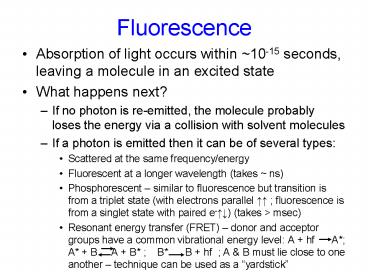Fluorescence - PowerPoint PPT Presentation
Title:
Fluorescence
Description:
Fluorescence Absorption of light occurs within ~10-15 seconds, leaving a molecule in an excited state What happens next? If no photon is re-emitted, the molecule ... – PowerPoint PPT presentation
Number of Views:140
Avg rating:3.0/5.0
Title: Fluorescence
1
Fluorescence
- Absorption of light occurs within 10-15 seconds,
leaving a molecule in an excited state - What happens next?
- If no photon is re-emitted, the molecule probably
loses the energy via a collision with solvent
molecules - If a photon is emitted then it can be of several
types - Scattered at the same frequency/energy
- Fluorescent at a longer wavelength (takes ns)
- Phosphorescent similar to fluorescence but
transition is from a triplet state (with
electrons parallel ?? fluorescence is from a
singlet state with paired e-??) (takes gt msec) - Resonant energy transfer (FRET) donor and
acceptor groups have a common vibrational energy
level A hf A A B A B B
B hf A B must lie close to one another
technique can be used as a yardstick
2
Energy Levels
3
(No Transcript)
4
Quantum Yield
- All of these processes compete with one another
- The quantum yield for fluorescence
- Each other process has a Q and all must add up to
1 - Two types of factors affecting Qfluorescence
- internal with more vibrational levels closely
spaced (more flexible bonds), fluorescence is
more easily quenched, losing energy to heat - best fluors are stiff ring structures Tryp, Tyr
- environmental factors such as T, pH, neighboring
chemical groups, concentration of fluors
generally more interesting
5
Instrumentation
- 90o measurement to avoid scattering or direct
transmitted beam - Very low concentration can be used to keep Ifluor
linear in concentration - 3. Sensitivity is very high since no bkgd signal
no difference measurement (blank) needed as in
absorption - 4. Measure either I vs lemitted for a given linc
emission spectrum OR measure I vs lexciting
at fixed lemitted excitation spectrum - 5. Simple fluorometer uses interference filters
for incident 90o emission better machines use
gratings and scan to get a spectrum
6
(No Transcript)
7
Spectra
- Record uncorrected spectra directly
- 3 types of corrections needed
- a.Output Io of light source varies with linc
- b. Variable losses in monochromators with linc
or emitted - c. Variable response of PMT with lemitted
- Typically absolute measurements are not done and
so no corrections are made only comparisons
8
Fluors
- Intrinsic chromophore e.g. Try, Tyr, Phe
best is Try Ifluor depends strongly on
environment - Extrinsic attach fluor to molecule of interest
must - Be tightly bound at unique location
- Have fluorescence that is sensitive to local
environment - Not perturb molecules being studied
- Examples ANS dansyl chloride fluoresce
weakly in water, but strongly in non-polar
solvents - Acridine O used with DNA green on d-s,
red-orange on s-s
9
Green on d-s DNA red-orange on s-s DNA
Weak in water strong in non-polar solvents
Used with DNA
10
Two Application Examples
- Detect conformational changes in an enzyme when a
co-factor binds - Denaturation of a protein
A w/o added co-factor B with added co-factor C
free Tryptophan
Helix-coil transition of a protein in 0.15 M
NaCl the protein is more stable higher T needed
for transition
11
FRAP
- High power bleach pulse
- Low power probe
- Look at 2-D diffusion
- ltr2gt 4Dt size2 beam focus
12
TIR-FRAP
Rhodamine labeled actin/phalloidin































